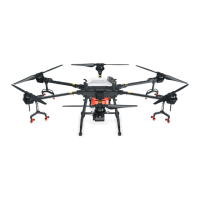©
2019 DJI All Rights Reserved.
3
AGRAS T16
User Manual
4. Operation
•
Stay away from the rotating propellers and motors.
•
The takeoff weight must not exceed 40.5 kg when using near sea level. Note that when using at a
higher sea level, the takeoff weight capacity will be reduced.
•
Once the operating altitude reaches 1 km (3,280 ft), the payload capacity of the spray tank is
reduced by 2 kg. For every additional km, the payload capacity will be reduced another 2 kg.
•
Maintain a visual line of sight (VLOS) of your aircraft at all times.
•
DO NOT use the Combination Stick Command (CSC) or other methods to stop the motors when
the aircraft is airborne unless in an emergency situation.
•
DO NOT answer incoming calls during flight. DO NOT fly under the influence of alcohol or drugs.
•
If there is a low battery warning, land the aircraft at a safe location.
•
If the radar module is unable to work properly in the operating environment, the aircraft will be
unable to avoid obstacles during RTH. All that can be adjusted is the flight speed and altitude, as
long as the remote controller is still connected.
•
After landing, stop the motors, power off the aircraft, and turn off the remote controller. Otherwise,
the aircraft may enter Failsafe RTH automatically due to remote controller signal loss.
•
Maintain full control of the aircraft at all times and do not rely on the DJI MG2 app. The obstacle
avoidance function is disabled in certain situations. Keep the aircraft within VLOS and pay close
attention to its flight. Use your discretion to operate the aircraft and manually avoid obstacles in a
timely manner. It is important to set an appropriate Failsafe and RTH altitude before each flight.
5. Maintenance and Upkeep
•
DO NOT use aged, chipped, or broken propellers.
•
To avoid damaging the landing gear, remove or empty the spray tank during transportation or when
not in use.
•
Recommended storage temperature (when the spray tank, flow meter, pumps, and hoses are
empty): between -20° and 40° C (-4° and 104° F).
•
Clean the aircraft immediately after spraying. Inspect the aircraft regularly. Refer to the Product
Care section for more information about maintenance guidelines.
6. Observe Local Laws and Regulations
•
You can find a list of DJI GEO zones at http://www.dji.com/flysafe. Note that the DJI GEO zones are
not a replacement for local government regulations or good judgment.
•
Avoid ying at altitudes above 30 m (98 ft).*
* In this document, the altitude limit of 30 m means the altitude between the aircraft and the surface of the objects below it
when the altitude stabilization function of the radar module is enabled. If the function is disabled, the altitude limit means
the altitude between the aircraft and the takeoff point.
The flying altitude limit varies in different countries or regions. Make sure to fly at the altitudes outlined by local laws and
regulations.

